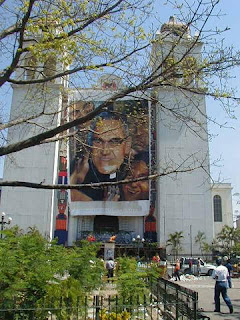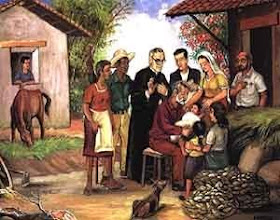ROMERO IN ART

Over the years, Archbishop Romero has inspired artists to produce works of art that pay tribute to Romero's life, commitment to the poor, and martyrdom. These works, in turn, can help us to appreciate dimensions of Romero's legacy and gain insights into Romero as only art can orient emotion and intellect. The ten artworks selected here do that very well.
1.
Romero, the 1989 film. Written by John Sacret Young (
The West Wing), directed by John Duigan (
Wide Sargasso Sea) and starring Raul Julia (
Kiss of the Spider Woman) as Archbishop Romero. Released within a decade of Romero's death, this first major motion picture financed by the Catholic Church brought (and continues to bring) the story of Romero to a worldwide audience. It is a great tool to build a Romero discussion around. Watch the trailer
here.
2.
Statue of Óscar Romero in the West Facade of Westminster Abbey, London. Sculptor: John Roberts. Unveiled in the presence of Queen Elizabeth II by the Archbishop of Canterbury in 1998, the statue fills a niche that had been empty since it was created during an addition to the Abbey in 1745 (the Abbey itself dates back to the year 960). Members of Romero's family were invited to the unveiling. Romero was one of 10 martyrs of the 20th Century selected for inclusion, along with Dr. Martin Luther King, Jr., Maximilian Kolbe, Dietrich Bonhoeffer, and others. Romero occupies a central place and was singled out to Pope Benedict XVI during his 2010 visit. You can read about it at the Abbey's
web site.
3.
Bishop Pedro Casaldáliga's poem "San Romero de América" ("Saint Romero of the Americas"). The title itself became a slogan promoting Romero as a popular hero-saint among the masses, and the pick-up-and-go portability of the poem make it easy to propagate, especially in the era of emails, list-servs, and socially conscious groups and chat rooms. Casaldáliga opens with an allusion to the
Angelus, ("On the eve, the Angel of the Lord announced" -- also a reference to the fact that Romero was assassinated on the Eve of the Feast of the Annunciation) and he closes with the line, "Saint Romero of America, our pastor and martyr/No one will silence your final homily!" Read an English translation of the poem
here. Hear a dramatic reading of the Spanish verse
here.
4.
The Catafalque over Romero's Tomb in the Crypt of the Metropolitan Cathedral of San Salvador. Sculptor: Paolo Borghi. Unveiled in March 2005 for the 25th Anniversary of Romero's martyrdom, it was clearly intended to coincide with Romero's beatification, which was thought to be imminent at the time. When the catalque was made public, Romero's grave was moved to a point immediately beneath the Cathedral's main altar and dome. The bronze sculpture was donated by the community of San Egidio in Italy and sculpted by Italian artist Paolo Borghi. It shows Romero guarded by the Four Evangelists as he "sleeps the sleep of the just." Read more about the Tomb of Archbishop Romero
here.
5.
Icon of Óscar Romero by Brother Robert Lentz (OFM). Like Casaldáliga's calling him "San Romero," Brother Robert's irreverent halo cut a striking figure in the public imagination, and the substitution of military helicopters for the customary angels behind this modern saint also commingled traditional spirituality with a gritty, modern reality -- a bit like Leonardo DiCaprio's
Romeo + Juliet (1996). Created in 1987, Brother Robert's icon harkens back to the ancient hagiography of Byzantine art. Read more about Brother Robert and his icon
here.
6.
The song "Homenaje a Monseñor Romero" by Alvar Castillo, of Yolocamba I Ta. Like poems, songs are made for the masses, and a saint that appeals to the masses also has inspired plenty of popular songs, especially in El Salvador. The best of these proclaims: "Monseñor, today you live in the heart of the People who loved you so well." But, in a prickly turn, the lyric goes on, "Monseñor, your truth compels us march to the final victory." The lyric reads like a battle hymn, and it unabashedly refers to Romero as a "symbol of rebellion." Like the "Battle Hymn of the Republic," this campaign ballad captures a spirit of resistance -- this one, inspired by Archbishop Romero's principled stands and makes Romero accessible to the youth. You can hear a recording of the song in this
video slide show. You can find the lyrics on the
Yolocamba I Ta web site.
7.
Statue of Óscar Romero at San Salvador's Plaza de las Américas. Sculptor: Napoleón Alberto Romualdo. Small by comparison to the nearby landmark
Divino Salvador del Mundo (Divine Savior of the World) monument, the Romero statute in West San Salvador is the principal Romero monument in the martyr's native country. Although the monument is modest in scale, there is something culturally audacious about a Romero statue in San Salvador's most affluent district,
Colonia Escalón, adjacent to the most iconic Salvadoran monument, the Divine Savior. In addition to the candlelight procession honoring Romero every year, many political marches originate here, keeping Archbishop Romero as much in the center of national spectacle as he was when he was living. See a night time view of the statue with the Divine Savior in the background,
here.
8.
Icon of the Martyrs and witnesses to Faith of the twentieth century at the Basilica of St. Bartholomew in Rome. The icon was commissioned by an ecumenical commission appointed by Pope John Paul II after the year 2000 Jubilee, and is styled based on motifs from the book of Revelation. Like the statues at Westminster Abbey, the icon depicts martyrs from different Christian denominations. Archbishop Romero is depicted in the bottom right hand corner, standing over a Eucharistic table while soldiers prepare to fire at him. At this time, the painting is the only authorized iconic depiction of Romero in a Catholic church. Pope Benedict paid tribute during a visit in 2008. You can see an image of the icon
here.
9.
Romero, The Musical, by George Daly and Liam Bauress. Created in 1982,
Romero, The Musical predates
Romero, the movie, and most of the other Romero-inspired artworks you likely will find. The London première in September 2009 sold out. Today,
Romero, The Musical is up to date, with a web site through which the creators want to transmit their work to the next generation, providing their librettos and "everything you need to put on a performance of Romero" to schools and theater groups all over the world. You can find the libretto, the director's script, the vocal score and even a DVD of the show at
The Musical's
web site.
10.
The 'Giant Painting' of Archbishop Romero (PHOTO). This is a great piece (literally), with a great story behind it. In 2005, a group of Salvadoran youths set out to paint the largest painting of Archbishop Romero in the world. They delivered, producing a 60 foot wide and 90 foot tall image of Romero that covered the entire facade of the San Salvador Metropolitan Cathedral when it hung there for the 25th Anniversary of Romero's martyrdom. The kids were so pleased with their work that they wanted to ship it to Cologne, Germany, for the Church's annual World Youth Day. Red tape and budget limitations conspired against them, and today the largest Romero painting is somewhere about 5 miles away from Cologne, the closest it got to world Youth Day, folded up and waiting to be rescued. You can read about the Giant Painting, and about how to help to salvage it at the artists'
web site (Spanish).
See also:
CREDITS FOR SOME IMAGES POSTED IN «SUPER MARTYRIO» INVOKING THE FAIR USE DOCTRINE:
Sunday, December 29, 2013:
“Archbishop Romero and the volcano,” and its Spanish/Italian counterparts, credit to: Mike Clemente, http://mikeclementte.tumblr.com/
Friday, December 27, 2013:
“Top 10 stories about Óscar Romero in 2013,” and its Spanish/Italian counterparts, credit to: RomeReports.com.
Friday, December 20, 2013
“Christmas with the poor,” and its Spanish/Italian counterparts, credit to: Universidad Centroamericana "José Simeón Cañas", Cartas a las Iglesias.
Saturday, December 07, 2013
“Waiting for Godot … ’s canonization,” credit to come.
Monday, December 02, 2013
“Abp. Romero and the Angelus,” and its Spanish/Italian counterparts, credit to: The Yorck Project: 10.000 Meisterwerke der Malerei. DVD-ROM, 2002. ISBN 3936122202. Distributed by DIRECTMEDIA Publishing GmbH.
Friday, November 29, 2013
“The Pope is not a Marxist,” credit: Papists http://www.flickr.com/photos/26114656@N08/sets/72157633013053257/with/8564061683/
Monday, November 25, 2013
“From Archbishop Romero’s last pastoral letter to «Evangelii Gaudium»,” and its Spanish/Italian counterparts, credit to: Servicios Pastorales, http://www.scribd.com/salvacham
Saturday, November 23, 2013
“Óscar Romero statue unveiled in L.A.,” and its Spanish/Italian counterparts, credit to come.
Friday, November 22, 2013
“Clear path for Archbishop Romero at the CCS,” and its Spanish/Italian counterparts, features a photo, credit to come.
Monday, November 18, 2013
“Targeting the Faith,” and its Spanish/Italian counterparts, features images, credit to come.
Wednesday, November 13, 2013
“Defending Maradiaga,” credit to come.
Tuesday, November 12, 2013
“Turning the tables on Wojtyla & Romero,” and its Spanish/Italian counterparts, credit: Oficina de Canonización de la Arquidiócesis de San Salvador.
Monday, November 11, 2013
“The ‘Frankies’,” credit: Catholic Spirituality Blogs Network .
Wednesday, November 06, 2013
“Quiz: Ratzinger or Romero?,” and its Spanish/Italian counterparts, credit to come.
Saturday, November 02, 2013
“El día de los muertos,” credit: EL FARO/Blanche Petrich.
Wednesday, October 30, 2013
“Archbishop Romero & All The Saints,” credit: Frederick Meza/EL FARO.
“Mons. Romero y Todos los Santos,” credit: Diario Colatino, Mar 21, 2011.
“Mons. Romero e Tutti i Santi,” credit: Frederick Meza/EL FARO.
Saturday, October 26, 2013
“El Pdte. Funes y Mons. Romero (Opinión),” credit to come.
Friday, October 25, 2013
“Irish president visits Archb. Romero’s grave,” and its Spanish/Italian counterparts, credit: Simon Carswell and the Office of the President of Ireland.
Thursday, October 24, 2013
“Answering a critic,” credit to come.
Wednesday, October 23, 2013
“Francis: Romero beatification “is on the right path”,” and its Spanish/Italian counterparts, credit: President of the Central American Parliament and Diario CoLatino.
Tuesday, October 22, 2013
“Archb. Romero in the Peripheries,” and its Spanish/Italian counterparts, credit: Fundación Romero.
Thursday, October 17, 2013
“The Church As Tree,” and its Spanish/Italian counterparts, credit: Foundation for Self-Sufficiency in Central America.
Thursday, October 10, 2013
“Overcomplicating Óscar Romero,” credit: www.newmancentre.org
“Vincenzo Paglia in the crosshairs,” credit to come.
“Mons. Paglia en las miras,” credit to come.
“Paglia nel mirino,” credit to come.
Thursday, October 03, 2013
“The Apostle of Human Rights,” and its Spanish/Italian counterparts, credit to come.
Monday, September 30, 2013
“Roncalli & Wojtyla,” credit to come.
Saturday, September 21, 2013
“London Cathedral inaugurates “Romero Space”,” and its Spanish/Italian counterparts, credit: Southwark Archdiocese Flickr account.
Friday, September 20, 2013
“The Week In Review,” and its Spanish counterpart, credit: Vatican Radio.
“La rassegna settimanale,” credit: the Archbishop Romero Trust.
“The Hermeneutic of Mercy,” credit: Christopher Furlong/Getty Images.
Sunday, September 15, 2013
“Romero in the Exaltation of the Cross,” credit: the Archbishop Romero Trust.
“Romero en la Exaltación de la Cruz,” credit to come.
“Romero nella Esaltazione della Croce,” credit Roberto Valencia, CAFOD (http://cafodwestminster.files.wordpress.com/2013/02/romero.png).














